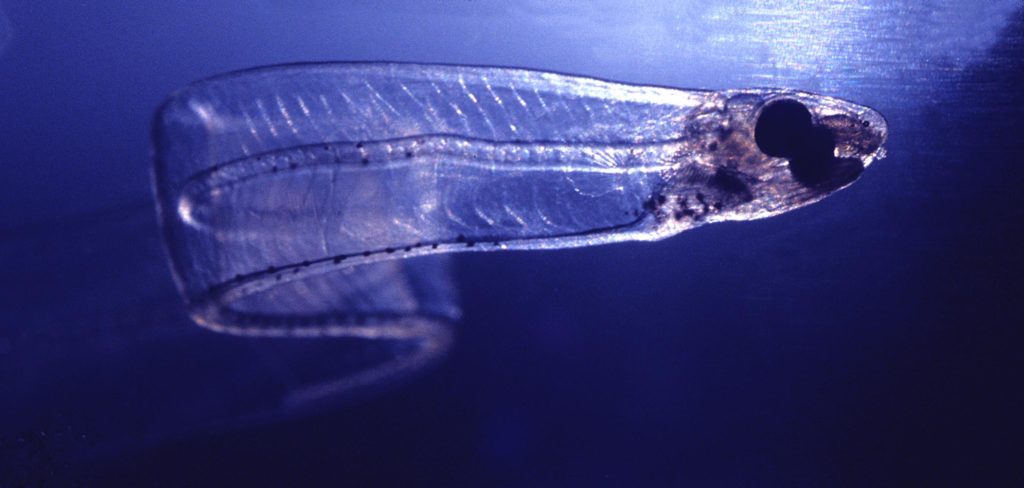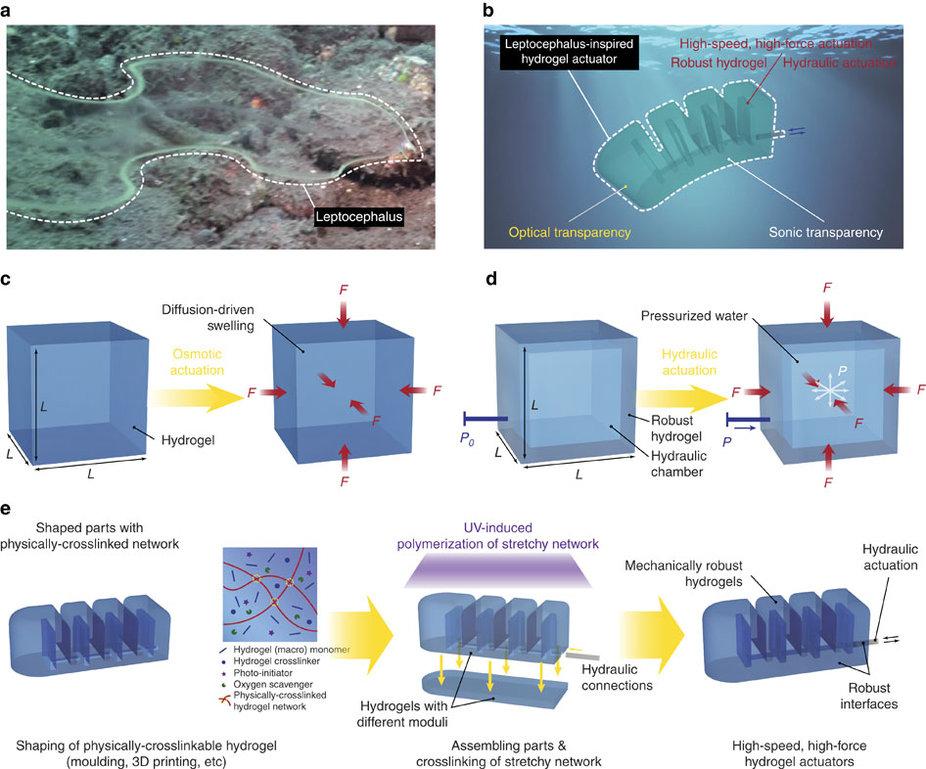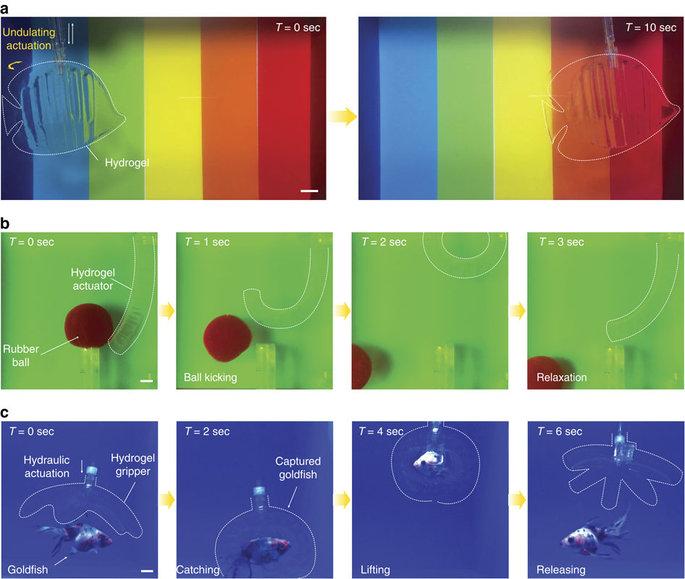 Soft robotics are becoming increasingly common as researchers and engineers develop new ways to fabricate robots from materials that range from flexible plastics to silicones. A team of engineers at MIT, however, has created a soft robot that, in a sense, is close to human in its composition, as it’s made almost entirely of water. The transparent hydrogel robots are really something to see – or not see, as they’re almost invisible underwater.
Soft robotics are becoming increasingly common as researchers and engineers develop new ways to fabricate robots from materials that range from flexible plastics to silicones. A team of engineers at MIT, however, has created a soft robot that, in a sense, is close to human in its composition, as it’s made almost entirely of water. The transparent hydrogel robots are really something to see – or not see, as they’re almost invisible underwater.
Each robot is composed of a series of hollow hydrogel structures connected to a series of rubbery tubes that allow the scientists to pump water into them. When the water is pumped in, they inflate and either stretch or curl up. The research team, led by Xuanhe Zhao, associate professor of mechanical engineering and civil and environmental engineering, and graduate student Hyunwoo Yuk, created several of the robots in different configurations, including a fishlike robot that flaps back and forth like a fin, an articulated appendage that kicks, and a handlike robot that squeezes and relaxes.
While there are several potential applications for the robots, the team is currently looking to adapt them for medical purposes.
“Hydrogels are soft, wet, biocompatible, and can form more friendly interfaces with human organs,” said Zhao. “We are actively collaborating with medical groups to translate this system into soft manipulators such as hydrogel ‘hands,’ which could potentially apply more gentle manipulations to tissues and organs in surgical operations.”
The project has been in the works for five years as the team experimented with different hydrogel formulations from polymers and water. They eventually came up with a tough, stretchy material that can be “glued” to various surfaces such as glass, metal, ceramic and rubber.
According to Zhao, hydrogel is superior to other soft robotic materials like rubber because of its biocompatibility, making it safe for use in biomedical applications as it’s mostly water. Their flexible, strong, bondable hydrogel has also shown itself to be superior to the brittle, inflexible hydrogel robots developed by other researchers, as those robots tend to crack or burst with repeated use.
“We didn’t think of this kind of [soft robotics] project initially, but realized maybe our expertise can be crucial to translating these jellies as robust actuators and robotic structures,” Yuk said.
Like other developers of soft robotics, the MIT team studied the animal kingdom for inspiration. They were particularly interested in leptocephali, aka glass eels, which are tiny, transparent, hydrogel-like eel larvae that hatch in the ocean and make their way to the rivers where their kind naturally lives.
“It is extremely long travel, and there is no means of protection,” Yuk said. “It seems they tried to evolve into a transparent form as an efficient camouflage tactic. And we wanted to achieve a similar level of transparency, force, and speed.”
He and Zhao used a combination of 3D printing and laser cutting techniques to form their hydrogels into hollow structures, which they bonded to rubbery tubes connected to external syringe pumps. Those pumps were used to inject water through the structures, causing them to curl or stretch depending on their configuration. While other researchers have activated hydrogel robots by letting water gradually seep in, creating slow, gentle movement, Zhao and Yuk discovered that by pumping the water, they could create fast, forceful reactions that generate a few newtons of force in one second.
“The moulds for each parts were fabricated using 3D printer (Form2; Formlabs) and laser cutter (Epilog Mini/Helix; Epilog Laser) based on computer-aided design drawings generated from commercial 3D modelling software (Solidworks; Dassault Systems),” the researchers wrote in their paper of the technologies behind the fabrication.
They also found that the structures could withstand up to 1,000 cycles of repeated use without rupturing or tearing. In addition, they were nearly invisible when placed underwater against different colored backgrounds. In one experiment, they fabricated a hydrogel robot that resembled a claw – very similar to those infuriating grabbers you see in restaurants and at fairs, that are supposed to pick up toys if you manipulate them correctly. Unlike those mechanical claws, however, which seem to exist only to tease children and get their parents to pour all their change into the machines, the hydrogel claw actually did what it was supposed to do.
By pumping water into one of the claw’s “fingers,” the researchers were able to make it open and close. They then submerged it in a fish tank; as a fish swam past, it opened and closed with enough speed and force to snare the fish securely in its grip. Despite its strength, however, its softness allowed the fish to remain unharmed as it was held and then released – boding well for Zhao’s theory that the robots could be used for safer, more gentle surgical procedures.
The team’s next step is to optimize the robots for various applications. The transparency of the current models makes the robots excellent candidates for underwater applications; as you can see in the video below, the nearly invisible robot claw sneaks up on the fish without it even seeming to notice. Medical procedures, however, may not benefit from such transparency, while other applications may require stiffer structures.
“We want to pinpoint a realistic application and optimize the material to achieve something impactful,” Yuk said. “To our best knowledge, this is the first demonstration of hydrogel pressure-based acutuation. We are now tossing this concept out as an open question, to say, ‘Let’s play with this.'”
The research was published today in a paper entitled “Hydraulic hydrogel actuators and robots optically and sonically camouflaged in water,” which you can read here. Additional authors of the study include Shaoting Lin, Chu Ma, Mahdi Takaffoli, and Nicolas X. Fang. The research was supported in part by the Office of Naval Research, the MIT Institute for Soldier Nanotechnologies, and the National Science Foundation. Discuss in the Hydrogel Robots forum at 3DPB.com.
[Source: MIT]
Subscribe to Our Email Newsletter
Stay up-to-date on all the latest news from the 3D printing industry and receive information and offers from third party vendors.
Print Services
Upload your 3D Models and get them printed quickly and efficiently.
You May Also Like
The Market and Industry Potential of Multi-Material 3D and 4D Printing in Additive Electronics
Additive manufacturing leverages computer-based software to create components for products by depositing either dielectric or conductive materials, layer by layer, into different geometric shapes. Since its birth in the 1980s,...
3DPOD 262: Bio-inspired Design for AM with Dhruv Bhate, Arizona State University
Dhruv Bhate is an associate professor at Arizona State University. There, he looks at structures, materials, and design. Previously, he worked at PADT as well as in the semiconductor and...
3DPOD 261: Tooling and Cooling for AM with Jason Murphy, NXC MFG
Jason Murphy´s NXC MFG (Next Chapter Manufacturing) is not a generalist service; instead, the company specializes in making tooling. Using LPBF and binder jet, the company produces some of the...
3DPOD 260: John Hart on VulcanForms, MIT, Desktop Metal and More
John Hart is a Professor at MIT; he´s also the director of the Laboratory for Manufacturing and Productivity as well as the director of the Center for Advanced Production Technologies....




































